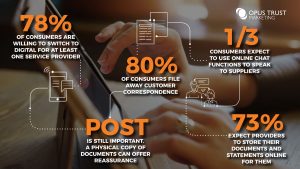 New research has shed fresh light onto the way customers prefer to receive correspondence from their suppliers, confirming the value of functional communications in building customer relationships and revealing changing consumer expectations as technology evolves.
New research has shed fresh light onto the way customers prefer to receive correspondence from their suppliers, confirming the value of functional communications in building customer relationships and revealing changing consumer expectations as technology evolves.
The survey of 2000 consumers was conducted by OnePoll on behalf of outsourced communications provider Opus Trust Marketing. It uniquely focuses on account-related communications as a key touchpoint, revealing that:
- Age has no bearing on consumer preferences, but the type of correspondence does;
- Within five years, a third of consumers across all age groups expect online chat functions to be their preferred method to communicate with service providers, equal to those expecting to use email;
- Functional communication holds real value, with 80% of respondents retaining and filing correspondence;
- There is no one-size-fits-all approach to customer communications, but suppliers need to provide customers with choice and easily editable preferences in order to meet their expectations.
The research confirmed that customer choices cannot be easily predicted by age or demographic and the main point of divergence was the type of communication itself, meaning businesses must assess their suite of correspondence to ensure each piece achieves cut through and elicits a response. A third of consumers prefer post for critical information and documents that need to be acted upon or stored, whereas email was more often the preferred way to receive regular communications, followed by online portals.
Digital Transition
Across all age groups, 78% of consumers were happy to switch to receive only digital communications from at least one service provider, particularly electronic bills and statements from financial services (46%) and utilities firms (51%). 42% of all consumers want to manage their accounts online without the need to contact their provider, including 45% of over-55s.
Apps were the only area that revealed a generational divide: over 20% of under-34s use apps to pay bills, compared to just 4% of over -55s, and they were consistently the least preferred tool for this age group (for example, four times as many under-34s use apps to view their current account statements compared to over-55s).
However, the preference for digital and ‘self-serve’ account management for some sectors doesn’t mean a hands-off approach for businesses: consumers still want the ability to contact suppliers directly and many expect email or SMS notifications for changes on their accounts or to notify them of any action required. The only sectors that bucked this trend were pensions and insurance, where the majority of customers prefer post for all correspondence.
Changing Expectations

There is also a shift in how customers want to contact their suppliers. Currently 42% of consumers expect to be able to discuss their account over the phone with suppliers (including 46% of 18-24 year olds, defying the ‘Generation Mute’ label) and 31% currently use the phone for general enquiries. However, only 16% expect to pick up the phone to their supplier in five years’ time and 33% expect to be using online chat bots or live chat functions, up 123% from today’s usage and slightly higher than the 31% expecting to communicate by email by 2023.
Account-related correspondence is also less disposable than direct mail: 80% of consumers file away at least one type of communication, with hard copies preferred by 62% of those who do. However, 60% of consumers also expect their provider to keep copies of documents online for them to access, reiterating the importance of including intelligent document management and retrieval in a company’s customer experience strategy.
Rob Alonso, Chief Executive of Opus Trust Marketing, said: “Regular communications speak volumes about a company but are overlooked as tool to help build customer relationships. The research unveils a hidden opportunity to turn conventional, more functional communications into engaging, relevant and informative customer experiences. The message from this report is clear: consumers value customer correspondence and they are embracing new technology and channels, but there is no one-size-fits-all communications strategy. Regardless of sector, consumers each have individual preferences and organisations must ensure they offer customers a choice of channels to enable them to customise their communications. The message being conveyed often has the biggest impact on preferred channel, making an omnichannel strategy even more important. Businesses should also act now to prepare for the future: consumers increasingly expect to use online chat functions, portals and apps to communicate with providers, and businesses must be ready to meet their changing expectations.”
Sector Spotlight
 The research also explored individual sectors in more detail, providing a more granular view of how consumers prefer to receive the different types of document and communications issued by different service providers.
The research also explored individual sectors in more detail, providing a more granular view of how consumers prefer to receive the different types of document and communications issued by different service providers.
Banks were ranked best at communicating with customers, gaining over a third of the vote. The sector has embraced an omnichannel strategy, investing in intuitive tools which appear to be working: over a quarter of bank customers prefer to use an online portal to view statements, and the vast majority prefer paperless communication for all but their welcome pack. However, 75% want direct communication by post or email for information that requires action or notifies them of changes, reflecting the wider trends observed in the report.
Insurance and pension customers were less likely to use online portals and apps, and over 50% preferred post when it comes to important documentation. Over three quarters of those consumers who receive policies and certificates from insurers prefer to do so through direct communication (post or email). Pension providers may have a challenge to achieve cut through: despite the introduction of workplace pensions for many adults, 29% of those aged 25-44 stated they did not receive any pension correspondence.
Lender customers also showed evidence of a shift towards digital: two thirds of credit card customers and those with loans prefer to receive statements and agreements, with around a fifth keen to use online portals. 60% of mortgage customers also prefer digital for statements and correspondence.
Utilities came top of all services that consumers were willing to switch to exclusively digital communications (51%). However, consumers still prefer post and email over managing their accounts through online portals and apps, reiterating the need for direct communications.
Councils: Compared to utilities, councils were further behind the digital curve, with over half of bill payers opting to receive post and fewer (9%) willing to use an online portal.
Travel companies have invested significantly in apps over recent years, yet 90% of consumers prefer to receive their travel documentation by post or email, and just 2% opting for an app.
To download a full copy of the report and view the sector findings in more detail, visit here.
Source: Opus Trust Marketing

You must be logged in to post a comment Login